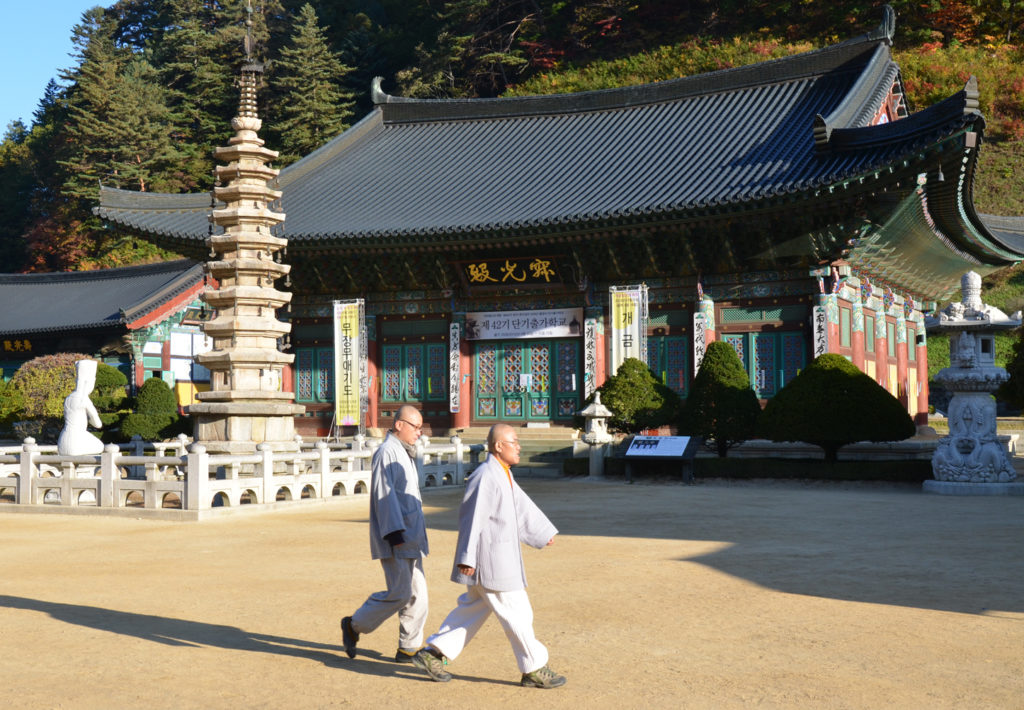By David DeVoss
The PyeongChang Olympics may be over, but that no reason to stop thinking about Korea. Indeed, now’s a great time to start planning ahead for warmer months. By all means head back to PyeongChang, which is beautiful with or without snow, but check out Seoul before you do.
Every Asian capital has excellent seafood restaurants but at Seoul’s Gwangjang night market you can order quivering fish fresh from the sea. Gangnam style literally comes alive on the South side of the Han River in trendy Apgujeong-Dong where the young and fashionable saunter between designer shops.
Before leaving Seoul most visitors will walk through one of the Moon Gates of Gyeongbokgung Palace and rest beneath the trees surrounding Cheong Wa Dae (the Blue House) where Korean President Moon Jae-in lives before starting the uphill climb to Buckchon Hanok Village, a sprawling outdoor museum of sorts where residents live in traditional tile-roofed homes of the sort that once spread across Seoul before the Korean War.
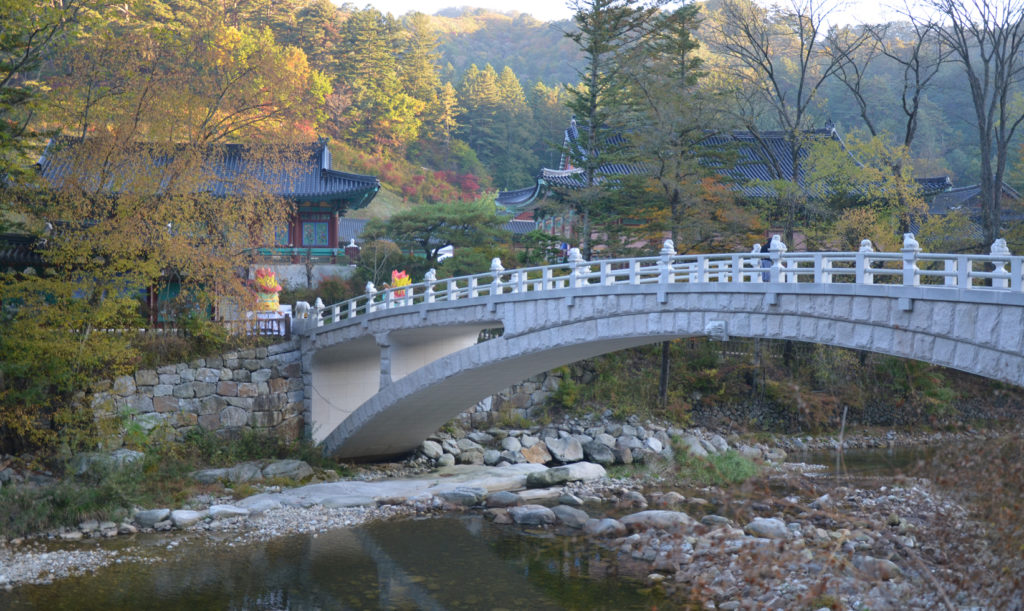
At Woljeongsa Temple, guests enter quietly, behabe respectfully and depart quietly being careful not to disturb the spiritual vibe and serene views
To get a real insight into Korean culture, however, try to spend at least one night before leaving Korea at one of the country’s 20 Buddhist temples able to accommodate English-speaking guests.
One temple close to PyeongChang and the North Korean border is Woljeongsa, an artfully crafted Buddhist retreat located beside a rippling creek in the middle of the Odasan National Park. From PyeongChang it takes one hour to drive to Woljeongsa through forest-covered mountains and rich agricultural valleys.
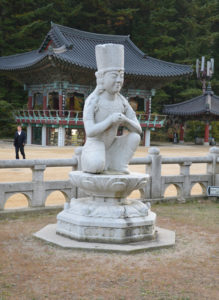
Greeting another person inside a Korean Buddhist temple starts with covering your left fist with your right hand and bowing
A Buddhist Temple stay in Korea is a highly structured experience. When I arrived at Woljeongsa, I was met by Eunyu (“Just call me Nicole”) Chong, a university student taking a semester away from school to manage the temple’s guest programs. After distributing loose fitting orange garments designed to be worn over regular clothing, she placed boxes of beads in front of each guest and told us to string a necklace with 108 beads. We later would offer our beads to Buddha at the evening prayer service.
As we bent to the task, Nicole explained the rules. “Try to speak as little as possible when you’re here and remain absolutely silent at dinner,” she advised softly. “Be neat and clean at all times and avoid all displays of affection.”![]() Hello, What’s up and How you doing? Were on the list of proscribed greetings. “If you wish to greet another person just wrap your right hand over your left hand and bow.”
Hello, What’s up and How you doing? Were on the list of proscribed greetings. “If you wish to greet another person just wrap your right hand over your left hand and bow.”
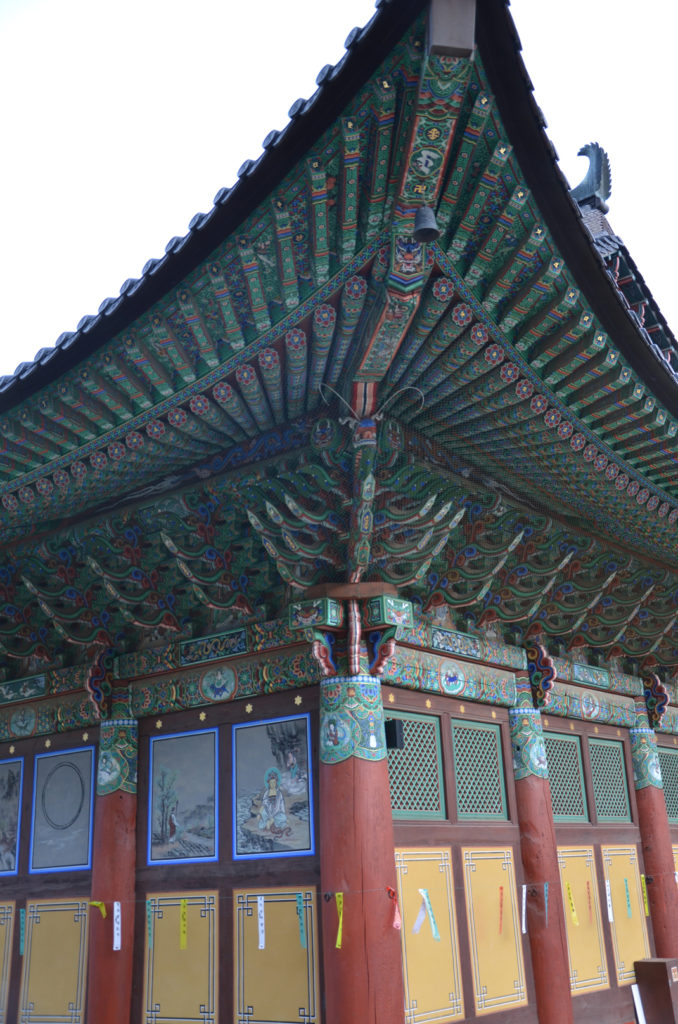
Buddhist temples are pieced together with glazed tiles, curved beams and inlays of scenes from the Buddha’s life
Visitors to Woljeongsa are segregated by sex and assigned to small dorm rooms unadorned save for a few wall pegs on which to hang clothes. Bedding is provided but blankets are barely needed since the “ondol” heating system under the floors keeps rooms warm even on cold nights. There are electrical outlets to recharge cell phones but don’t bother asking for a WiFi password. At 9 pm guests are expected to turn off all lights and go to bed.
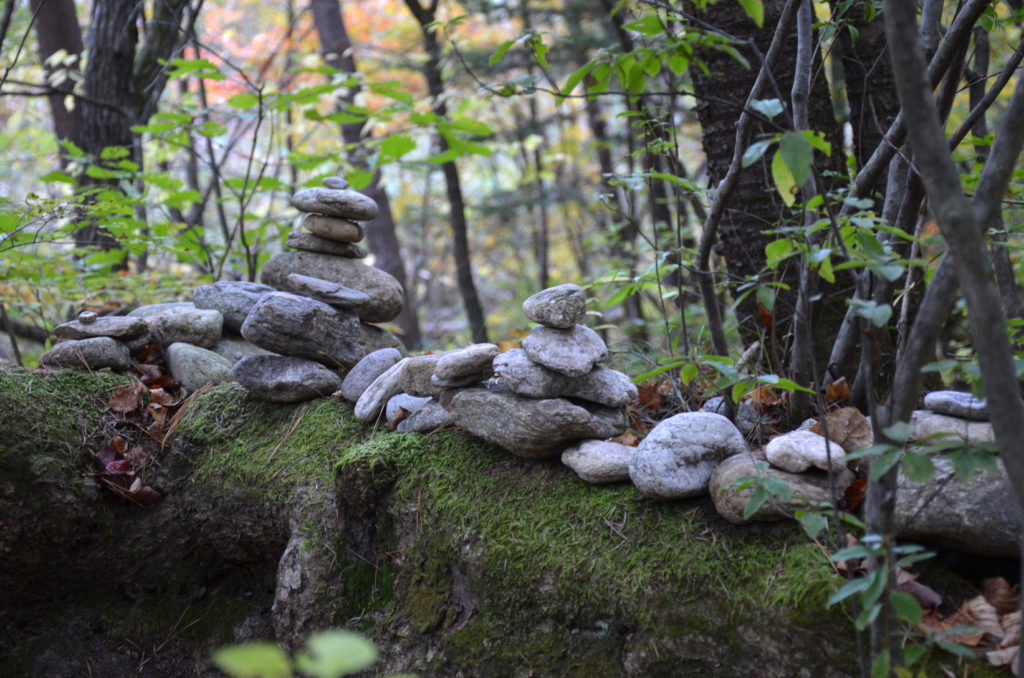
Forest trails around Woljeongsa are intended for contemplation as well as exercise. Piled up rocks represent prayers left by previous guests
Serenity prevails at Woljeongsa both inside the temple complex and along the trails that radiate out into the forest. For the first three hours of my stay I kept feeling I should be doing something. Anything. Slowly I began to realize as I ambled along trails leading into the forest or sat silently beside the creeks looking at pebbles stacked to resemble pagodas that Buddhism does not call temple guests to action. Instead a temple stay is designed to produce an appreciation for what Catholic theologian turned Zen philosopher Thomas Merton called the “wisdom of emptiness.”
“Solitude is not something you must hope for in the future,” Merton wrote. “Rather, it is a deepening of the present, and unless you look for it the present you will never find it.”
Dinner at Woljeongsa consists of tea, rice, steamed vegetables and a few sprouts served cafeteria style. Guests are encouraged to eat quickly and leave. This is easily done when dinner lacks flavor and conversation.
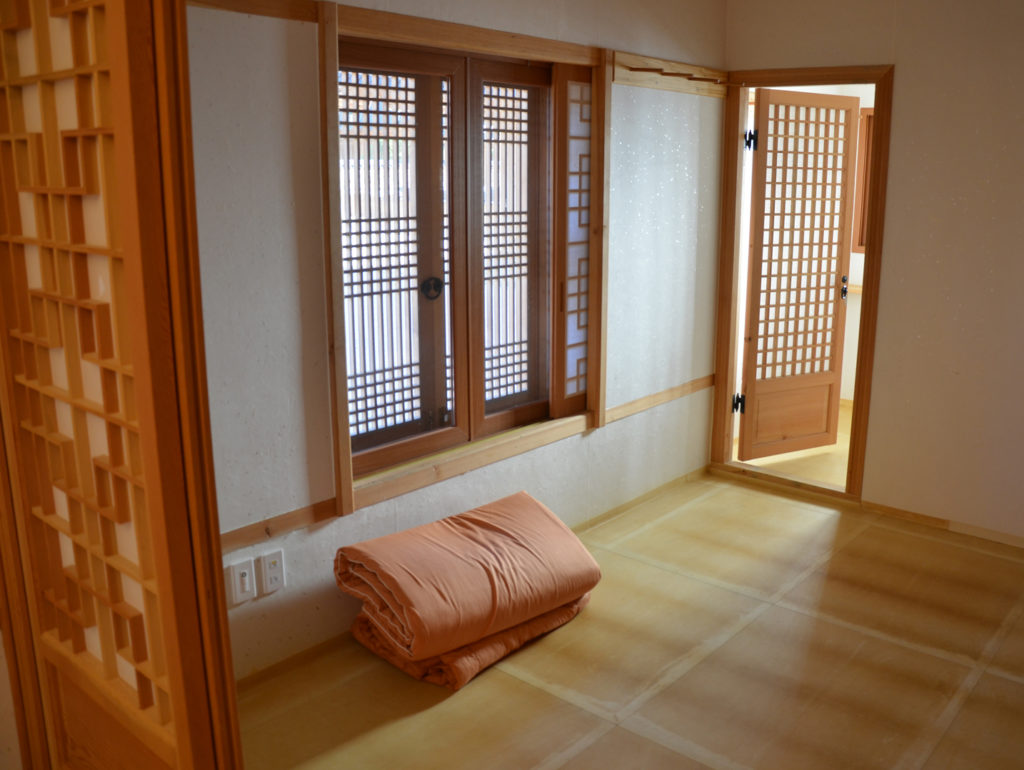
Sleeping rooms in a temple are spartan but warm. Guests sleep on a pad and are given a blanket and loose-fitting clothing to wear for the duration of the stay
Bedtime comes early in a Korean temple. So does morning prayer. At 4 am an enormous temple bell begins to toll. It is a signal for us to get up and wash since prayers begin promptly at 4:20 am. The bell sounds when struck with a heavy wooden clapper suspended from the bell tower with ropes. It takes two monks to muster the force necessary to ring the bell.
After prayers I return to the forest determined to find a high point to watch the sun rise. Wind gently stirs the fir trees while a gurgling brook nearby provides the only sound. I’m one with the shadows and Gangnam feels very far away.![]()
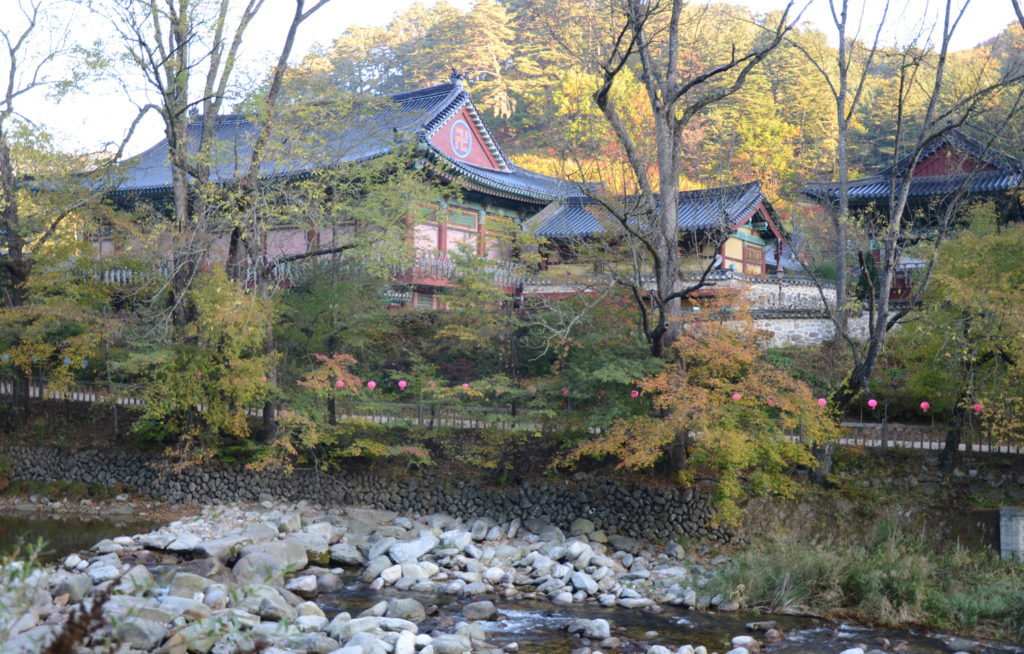
Sounds from a mountain creek and wind blowing through the surrounding forest complement the thrumb of temple bells calling monks to prayer
_________________________
David DeVoss is the editor of the East-West News Service
0 – 0 – 0
Twenty Buddhist temples located throughout Korea accommodate English-speaking guests for overnight stays or longer. Rules are strict. Temple etiquette demands modest attire and restrained, contemplative behavior. No smoking is allowed and attendance at Buddhist prayer services is expected. Reservations are required but are easily obtained at http://eng.templestay.com.
Temple Location Telephone Contact
Bongeun-sa Seúl 82-2-3218-4826 http://www.bongeunsa.org
Geumsun-sa Seúl 82-2-395-9955 http://www.geumsunsa.org
Myogak-sa Seúl 82-2-763-3109 http://www.myogaksa.net
Centro Internacional Seon Seúl 82-2-2650-2242 http://www.seoncenter.or.kr
Yongjoo-sa Gyeonggi 82-31-235-6886 http://www.yongjoosa.or.kr
Jeondeung-sa Incheon 82-32-937-0152 http://www.jeondeungsa.org
Woljeong-sa Gangwon 82-33-339-6606 http://www.woljeongsa.org
Beopju-sa Chungbuk 82-43-544-5656 http://www.beopjusa.or.kr
Magok-sa Chungnam 82-41-841-6226 http://www.magoksa.or.kr
Geomsan-sa Jeonbuk 82-63-542-0048 http://www.geumsansa.org
Naeso-sa Jeonbuk 82-63-583-3035 http://www.naesosa.org
Seonun-sa Jeonbuk 82-63-561-1375 http://www.seonunsa.org
Hwaeom-sa Jeonnam 82-61-782-7600 http://hwaeomsa.org
Mihwang-sa Jeonnam 82-61-533-3521 http://www.mihwangsa.com
Golgul-sa Gyeongbuk 82-54-775-1689 http://www.sunmudo.com
Jikji-sa Gyeongbuk 82-54-429-1716 http://www.jikjisa.or.kr
Haein-sa Gyeongnam 82-55-934-3110 http://www.haeinsa.or.kr
Donghwa-sa Daegu 82-53-982-0223 http://www.donghwasa.net
Beomeo-sa Busan 82-51-508-5726 http://www.beomeo.kr
Yakchun-sa Jeju 82-64-738-5000 http://www.yakchunsa.org


